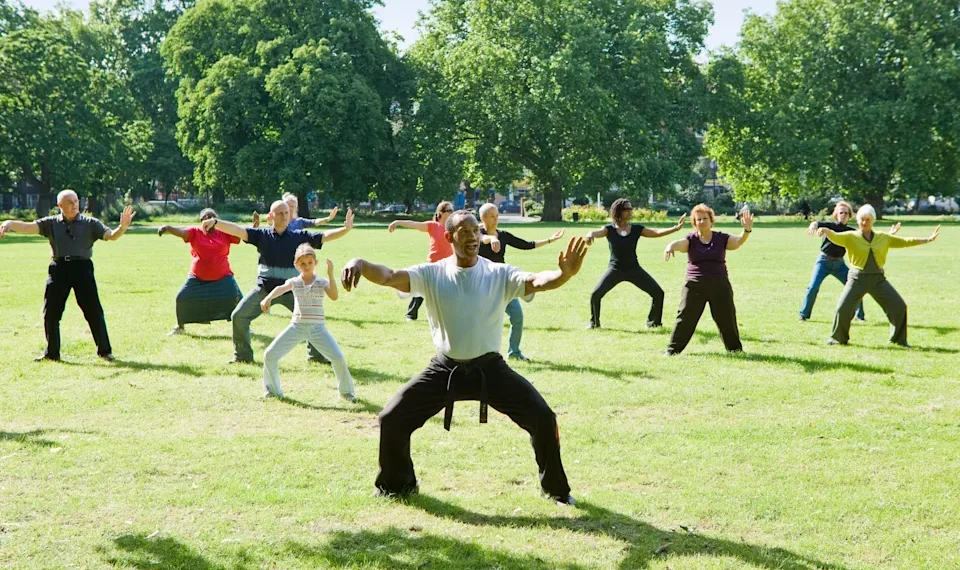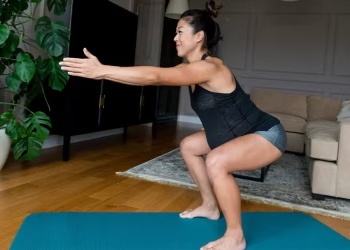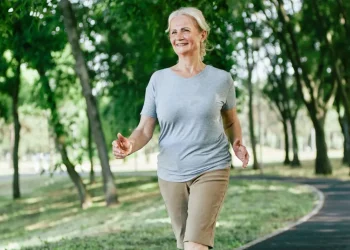In an era where rushing has become the norm, the ancient practice of Tai Chi walking offers a powerful counterbalance. This mindful movement practice, rooted in centuries-old Chinese martial arts tradition, transforms the simple act of walking into a profound mind-body exercise. Unlike conventional walking, Tai Chi walking emphasizes deliberate, flowing movements coordinated with conscious breathing and mental focus, creating a moving meditation that offers remarkable benefits for physical, mental, and emotional well-being.
As modern research increasingly validates what Eastern practitioners have known for centuries, Tai Chi walking has emerged as an accessible, low-impact exercise suitable for people of all ages and fitness levels. This article explores the multifaceted benefits of this gentle practice, supported by scientific evidence and practical applications.
Understanding Tai Chi Walking
Tai Chi walking, sometimes called “walking meditation” or “mindful walking,” integrates fundamental Tai Chi principles into ambulatory movement. The practice involves walking slowly and deliberately while maintaining specific postural alignments, coordinating breath with movement, and cultivating present-moment awareness. Key elements include:
- Weight shifting: Carefully transferring weight from one leg to another with full awareness
- Postural alignment: Maintaining an upright spine, relaxed shoulders, and a tucked chin
- Rooted steps: Placing each foot deliberately, feeling the connection with the ground
- Breath coordination: Synchronizing inhalation and exhalation with movement patterns
- Mental focus: Directing attention to bodily sensations and movement quality
This mindful approach to walking can be practiced anywhere—in parks, gardens, hallways, or even small indoor spaces—making it exceptionally accessible.
Physical Benefits: Building Strength from the Ground Up
Enhanced Balance and Stability
Perhaps the most extensively researched benefit of Tai Chi walking is its profound impact on balance and stability. A systematic review published in the Journal of the American Geriatrics Society analyzed multiple studies involving older adults and found that Tai Chi-based interventions, including walking practices, reduced fall risk by approximately 43%. The slow, controlled weight transfers inherent in Tai Chi walking strengthen the proprioceptive system—the body’s ability to sense its position in space—which naturally declines with age.
Research from the Oregon Research Institute demonstrated that participants who practiced Tai Chi walking for six months showed significant improvements in single-leg standing time and reduced postural sway compared to control groups. These improvements translated directly into better functional balance during daily activities.
Fall Prevention in Older Adults
Falls represent a leading cause of injury and loss of independence among older adults. The deliberate, controlled nature of Tai Chi walking creates a safe environment for challenging and improving balance systems. A landmark study in the New England Journal of Medicine involving 256 physically inactive adults aged 70-92 found that Tai Chi practice reduced falls by nearly 55% compared to stretching exercises.
The practice strengthens ankle and leg muscles crucial for recovery when balance is threatened, while simultaneously training the neuromuscular responses needed to prevent falls before they occur.
Improved Lower Body Strength and Flexibility
The continuous weight-shifting and semi-squatting positions used in Tai Chi walking provide excellent lower body conditioning without the joint stress of high-impact activities. Research published in the Archives of Physical Medicine and Rehabilitation showed that regular Tai Chi practitioners demonstrated significantly greater knee extensor strength and flexibility compared to sedentary peers.
The practice particularly benefits the quadriceps, hip flexors, and ankle stabilizers—muscle groups essential for mobility and independence in later life. The flowing movements also promote joint flexibility and range of motion, potentially reducing stiffness associated with arthritis and aging.
Cardiovascular and Metabolic Benefits
While Tai Chi walking appears gentle, research indicates it provides meaningful cardiovascular benefits. A study in Preventive Cardiology found that regular Tai Chi practice improved aerobic capacity, reduced blood pressure, and enhanced lipid profiles in middle-aged and older adults. The moderate-intensity nature of the practice makes it particularly suitable for individuals with cardiovascular conditions or those beginning an exercise program.
Additionally, research suggests Tai Chi walking may help regulate blood sugar levels. A study involving individuals with type 2 diabetes showed that a 12-week Tai Chi program improved glycemic control and increased overall physical functioning.
Mental Benefits: Cultivating Cognitive Wellness
Stress Reduction and Relaxation Response
Tai Chi walking activates the parasympathetic nervous system—the body’s “rest and digest” mode—counteracting the stress response that dominates modern life. Research published in Complementary Therapies in Medicine demonstrated that participants practicing Tai Chi showed significantly reduced cortisol levels (the primary stress hormone) compared to control groups.
The meditative quality of the practice, combining rhythmic movement with focused breathing, induces what Harvard researcher Herbert Benson termed the “relaxation response”—a physiological state characterized by decreased heart rate, lowered blood pressure, and reduced muscle tension.
Enhanced Cognitive Function
Emerging research suggests Tai Chi walking may offer neuroprotective benefits. A study published in the Journal of Alzheimer’s Disease found that older adults who practiced Tai Chi regularly showed increased brain volume in regions associated with memory and executive function. The practice’s demands on attention, coordination, and spatial awareness appear to provide cognitive stimulation that supports brain health.
Research from the University of South Florida demonstrated that eight months of Tai Chi practice resulted in improvements in cognitive function tests, particularly in areas of memory, attention, and processing speed. The mindful component of the practice may be particularly important, as it trains sustained attention—a cognitive skill that often declines with age.
Improved Sleep Quality
Sleep disturbances affect millions of people worldwide, with consequences ranging from impaired cognitive function to increased disease risk. A randomized controlled trial published in Sleep Medicine revealed that Tai Chi practitioners experienced significant improvements in sleep quality, reduced time to fall asleep, and decreased daytime dysfunction compared to control groups receiving health education.
The practice’s stress-reducing effects, combined with gentle physical exertion and mindfulness training, create optimal conditions for restful sleep.
Emotional Benefits: Nurturing Inner Peace
Mood Enhancement and Depression Reduction
Multiple studies have documented Tai Chi’s positive effects on mood and emotional well-being. A meta-analysis examining 33 studies published in BMC Complementary and Alternative Medicine found that Tai Chi significantly reduced symptoms of depression and anxiety across diverse populations.
The combination of physical movement, mindful awareness, and social connection (when practiced in groups) appears to create a particularly effective intervention for mood disorders. Research suggests the practice may increase levels of brain-derived neurotrophic factor (BDNF), a protein that supports neuron health and is often reduced in depression.
Anxiety Management
For individuals dealing with anxiety, Tai Chi walking offers a grounding practice that anchors attention in present-moment physical sensations. A study in the Journal of Psychiatric Practice found that participants with anxiety disorders who practiced Tai Chi experienced significant symptom reduction comparable to cognitive-behavioral therapy in some measures.
The practice teaches practitioners to remain calm while moving through space—a skill that transfers to navigating stressful life situations with greater equanimity.
Enhanced Self-Efficacy and Well-Being
Regular practice of Tai Chi walking often leads to increased self-efficacy—the belief in one’s ability to accomplish tasks and cope with challenges. Research published in Psychology of Sport and Exercise found that Tai Chi practitioners reported higher levels of self-efficacy and general well-being compared to non-practitioners.
This enhanced sense of capability may stem from mastering the practice’s physical challenges, experiencing tangible health improvements, and developing greater body awareness and confidence in movement.
Real-World Applications: Integrating Tai Chi Walking into Daily Life
For Older Adults and Fall Prevention Programs
Many senior centers, retirement communities, and healthcare facilities now incorporate Tai Chi walking into wellness programs. The practice offers an evidence-based intervention for fall prevention that participants generally find enjoyable and sustainable.
Healthcare providers increasingly recommend Tai Chi walking for patients concerned about balance or those recovering from falls. Its low-impact nature makes it suitable even for individuals with limited mobility or chronic conditions.
For Stress Management in the Workplace
Progressive organizations are introducing brief Tai Chi walking sessions during work hours as stress management tools. Five to ten minutes of mindful walking can reset the nervous system, improve focus, and enhance productivity. Employees report feeling more centered and less overwhelmed after practice.
For Mental Health Support
Mental health practitioners are integrating Tai Chi walking into treatment plans for depression, anxiety, and post-traumatic stress disorder. The practice provides a somatic (body-based) approach to emotional regulation that complements traditional talk therapy.
For Chronic Pain Management
Individuals with chronic pain conditions, including fibromyalgia and arthritis, often find Tai Chi walking offers relief without exacerbating symptoms. The gentle movements improve circulation, reduce muscle tension, and provide distraction from pain while building strength and flexibility gradually.
For Rehabilitation and Physical Therapy
Physical therapists incorporate Tai Chi walking principles into rehabilitation programs for patients recovering from surgery, stroke, or injury. The practice helps retrain movement patterns, rebuild confidence in mobility, and prevent future injuries.
Getting Started with Tai Chi Walking
Beginning a Tai Chi walking practice requires no special equipment or location. Start with just five minutes daily:
- Find a quiet space where you can walk slowly without interruption
- Stand in proper posture: feet shoulder-width apart, knees slightly bent, spine upright
- Begin walking very slowly, placing each foot deliberately
- Coordinate breathing: inhale as you shift weight, exhale as you step
- Keep attention focused on physical sensations and movement quality
- Gradually increase duration as comfort and skill develop
Many communities offer Tai Chi classes where walking is taught alongside other movements. Online resources and instructional videos can also provide guidance for home practice.
Conclusion
Tai Chi walking represents a rare convergence of ancient wisdom and modern science. Its gentle, accessible nature belies profound benefits spanning physical health, mental clarity, and emotional balance. As research continues to document its efficacy across diverse populations and conditions, this timeless practice offers a path to wellness that respects both body and mind.
In a world that often demands we move faster, Tai Chi walking reminds us that slowing down—moving with intention, breath, and awareness—may be the most powerful step we can take toward health and vitality. Whether seeking to prevent falls, reduce stress, enhance cognitive function, or simply find moments of peace in busy days, this mindful movement practice offers benefits that extend far beyond the duration of each walking session, gradually transforming how we move through life itself.
The evidence is clear: by walking with the wisdom of Tai Chi, we don’t just move our bodies—we cultivate resilience, balance, and well-being that supports flourishing across all dimensions of life.






